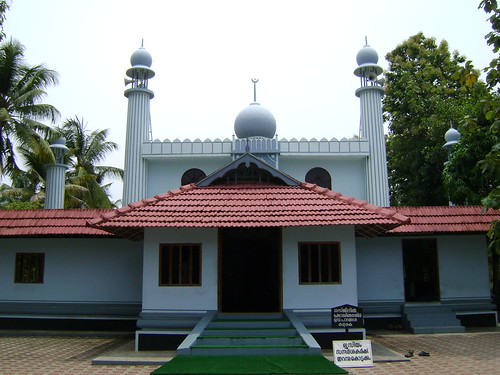This mosque is India's first, Prophet's contemporary
By Arvind Padmanabh
Kodungallur (Kerala) : One will find nothing unusual about this place of worship for Muslims as one drives past this town in central Kerala, just 30 km north of Kochi. But it's when you go in and chat up with the volunteers and office-bearers that the enormity of its legacy actually hits you.

Cheraman Juma Masjid, as it stands now (Photo Courtesy: TCN).
For Cheraman Jum'ah Masjid in this town, also known by its anglicised name Cranganore, is not just the oldest in India and the subcontinent but one built during the lifetime of Prophet Mohammad in 629 AD by an Arab propagator of Islam, Malik Ibn Dinar.
It is also testimony to two facts. One, Islam came to India long before the Mughals came in from the northwest. Two, the entry of Islam was smooth and Muslims enjoyed the full patronage of the locals irrespective of their religions - a facet that is still visible and cherished here.
This mosque stands proud with two other landmarks of Kodungallur, also known as Muziris. The first is the Saint Thomas Church, also said to be among the first in India built by the Apostle himself around 52 AD. He had arrived here in India and the church has some holy relics from the olden days. The second is the Bhagavathy Temple of Cheran ruler Chenguttavan, also known as Vel Kelu Kuttuvan, around 150 AD.
In fact, in a manifestation of India's cultural syncretism, many non-Muslims are its devotees and hold "Vidhyarambham", or the commencement of education ceremony for their children at this mosque. During Ramadan, iftaar offerings are often made by the non-Muslim communities in the area.
There are several legends surrounding the Cheraman Jum'ah mosque. As one goes: It was built under the patronage of the last Chera king, Cheraman Perumal, who is also believed to have abdicated his throne and embraced Islam upon meeting the Prophet at Mecca.
But before he died at Dhufar in Oman due to some illness on the way back to India, he wrote some letters asking the local rulers, to whom he had handed over his empire, to extend all help they could to some Arab merchants who were planning to visit India.
One such merchant, Malik Ibn Dinar, was given permission by local chieftains to build Islamic places of worship around the area. The mosque accordingly is called the Cheraman Mosque in recognition of the help extended by the last Chera ruler.
This apart, Malik Ibn Dinar, who was also a "sahaba" or a companion of the Prophet, was the mosque's first Ghazi, succeeded by his nephew Habib Bin Malik. Both Habib Bin Malik and his wife are entombed at the Cheraman Juma Masjid.
The original mosque itself has undergone several renovations. The oral traditions have it that the first such refurbishment took place in the 11th century and again some 300 years later. In the modern era a revamp was done in 1974, after which a reconstruction happened in 2001.
But all along, the sanctum sanctorum has been preserved. Minarets and a dome are also modern-day additions. Yet, despite the renovations, a striking amalgam of different cultures and religions is in full play at the grand old mosque.
From some angles, it can even pass off as a temple.
At the centre of this striking blend of several architectural styles and practices is a traditional Kerala-style lamp hanging from the ceiling. This lamp also has inscriptions in old Malayalam script Vattezhuthu.
In true style of temples in the south, the mosque also has a pond. Then the minber, or the pulpit from where the Imam delivers sermons, has some intricate carvings and lacquer work, which is again unique to southern India.
The mosque also has a small museum. At the centre, inside a glass casing, is a miniature replica of the mosque as it stood around 350 years ago. There are also some other artefacts from the times gone by, such as the redstones that were used to as building material in sizes uncommon today, and an ancient sewage channel.
Pl see my blogs;
Feel free -- and I request you -- to forward this newsletter to your lists and friends!